For many of you veteran coaches that read this site — did the term “Loaded Option” bring back some memories of the 70’s and 80’s in college football? Oregon is bringing back that wrinkle as a new variation to the Zone Read plays the Ducks operate from. It is a clever innovation emerging from the Helfrich/Frost offensive brain trust in Eugene, and I find myself fascinated at what plays we have seen and what hybrids are to follow.
Many of you forget that I am not a coach, but simply a hack fan who wants to share what I learn with you. Only due to the time given and generosity of the guest coaches do we learn more about football, and the impact that Oregon has on the sport. I was fortunate to have the entire subject of the loaded option explained to me by none other than the Grizzled Ol’ Coach, Mike Morris, as he laid out where this new play came from and how Oregon has morphed it into a nasty new weapon in the Ducks’ spread offense attack.
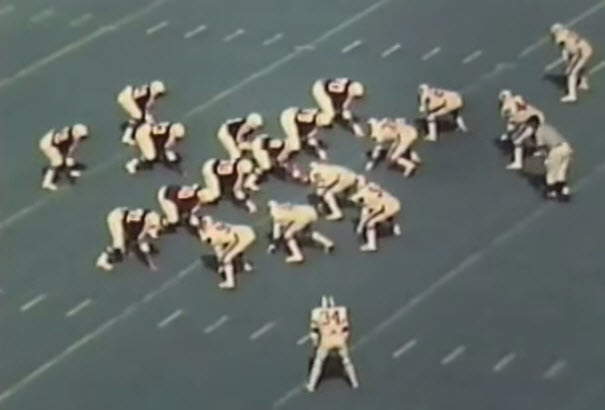
The Wishbone from the late 1970s!
Above is a screenshot of the beginning of a play out of the wishbone formation/offense that flourished primarily in the 70’s and 80’s throughout college and high school football. The triple option began with a dive play option for the fullback, or a QB keeper, (depending upon the defense’s reaction) or finally a trailing halfback could take a pitchout from the QB. The lead RB to either side would block the defender responsible for the pitchman trailing, thus something was usually open if the blocks and reads by the quarterback were done correctly.
The problem that surfaced over time with the wishbone was that the QB was hit on every play since he was right there up close to the line of scrimmage — unlike Oregon’s current shotgun formation. It was from this problem that the “Loaded Option” was born to allow for the QB to run without getting pounded on every play. In short, the defender assigned to stop/hit the QB is now being blocked by the lead running back, and no longer is the pitch defender being blocked. Instead, the defender assigned to stop the QB is blocked, and this opens up runs for talented QBs. (Are you beginning to see the reason Oregon adopted it?)

Oregon’s tight end, or F-back will kick-out…
A blocking strategy covered recently was the use of the “F-Back” in the Pistol offense to kick out the defensive end on the opposite side of the formation as we see above, indicated with the Duck tight end, who will run to his right (yellow dotted line).

Great kick-out and hole created by the TE or F-back.
It is a superb strategy as the TE has blasted a nice hole for the Oregon running back to dash through.
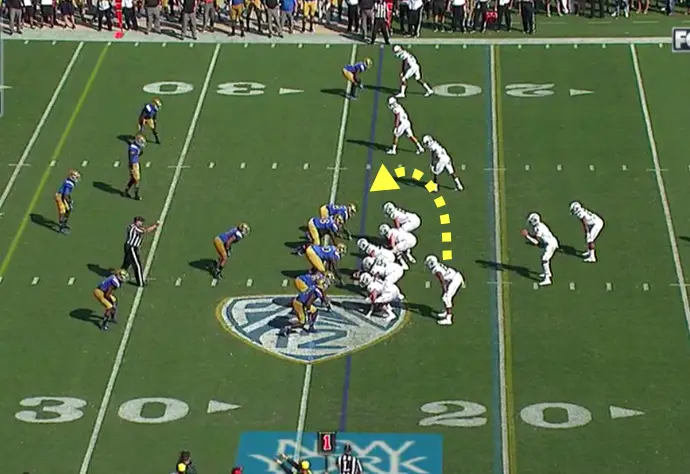
The F-Back “hooks” the block for Mariota?
Above we see the beginning of another play against UCLA. The F-back is going to go around and “hook” the OLB or defensive end to allow a running play to the outside (dotted yellow line/arrow).
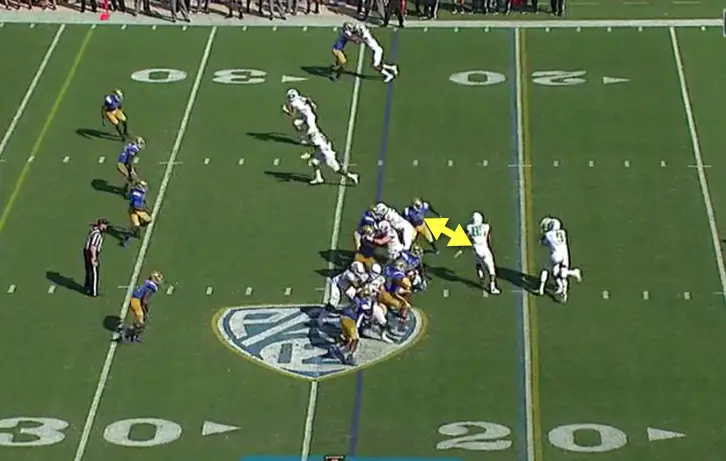
It is hard to hook this defender when he has penetrated the LOS so quickly.
Mariota appears to be doing a zone read while Oregon’s F-back (Pharoah Brown) realizes that hooking the defender inside is going to be difficult without giving him an inside lane to blow up the play.
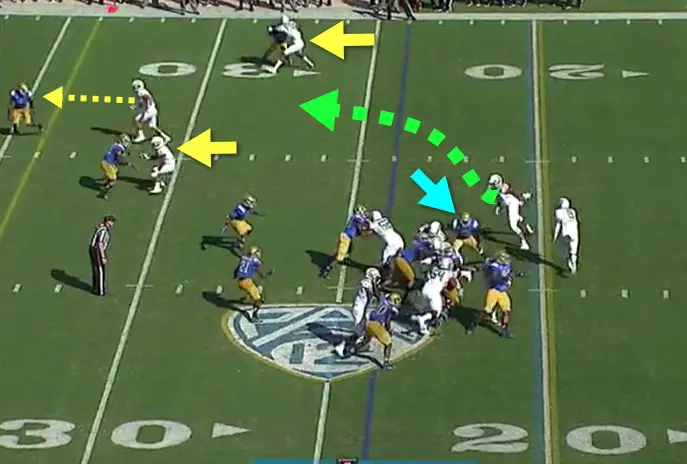
Bump and run!
Pharoah Brown (dotted green line/arrow above) did a nice job of bumping the defender (light blue arrow) to the inside as Marcus has pulled the ball and is running for the sideline! He knew the defender could not catch up and as you see — the Bruin is still looking inside to the Oregon RB.
The Ducks have great blocking downfield (yellow arrows above) as it becomes apparent that this was NOT a zone read at all, but a predetermined running play for Marcus Mariota.
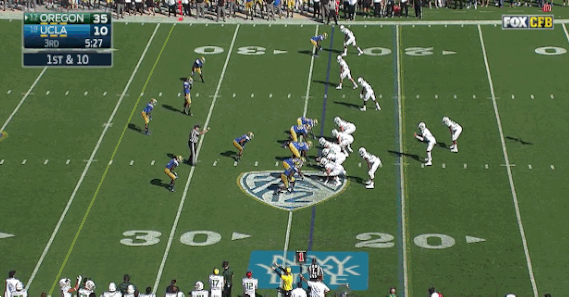
The “hook-em” strategy!
Some call this version of the play above the quarterback power, but before naming it — we need to see how it progresses in upcoming games!
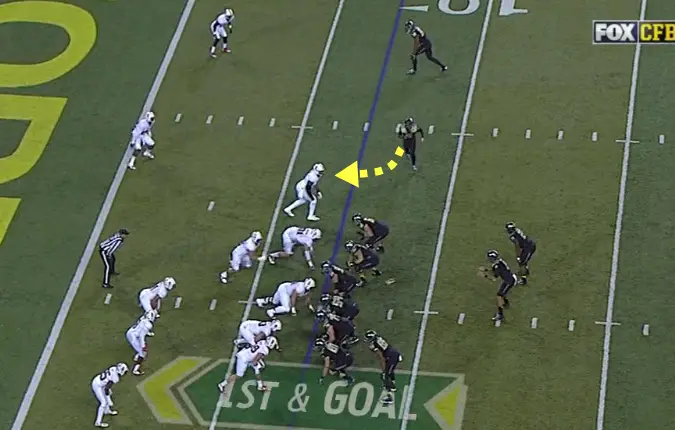
Blocking the defender responsible for the QB from a different direction!
You recognize the play above from the Stanford game, but the intent is the same as the “Loaded Option” in the wishbone, or the previous UCLA example. Oregon wants to block the Cardinal defender responsible for the QB to free Mariota on a predetermined running play. Charles Nelson goes in motion from his slot receiver position to line up for a crack-back block (yellow dotted line/arrow above).
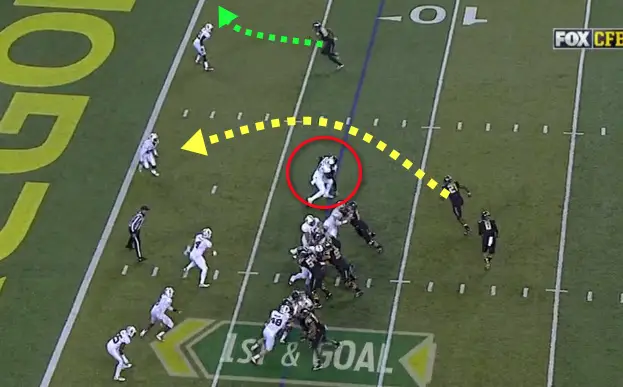
There is no zone reading here…
For a smaller guy, Charles Nelson does a wonderful job taking the defender responsible for the QB out of the play (red circle above). We see how the lead back (Royce Freeman and dotted yellow line/arrow) is targeting the safety while the WR (green dotted line/arrow) is running the corner out of the play.
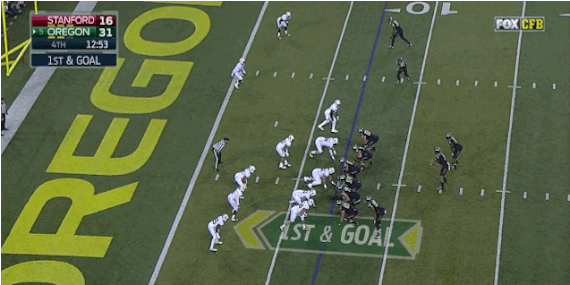
Big Block by a little player — Charles Nelson (5-9, 170, true freshman) has No. 9 James Vaughters (6-2, 254 senior) for lunch!
In the past, the Oregon QB would run dependent upon the “read” of the defense, thus the opposing defense could determine when they allowed the QB to take off, yet with the Duck version of the “Loaded Option,” (above) the choice becomes Oregon’s to make.
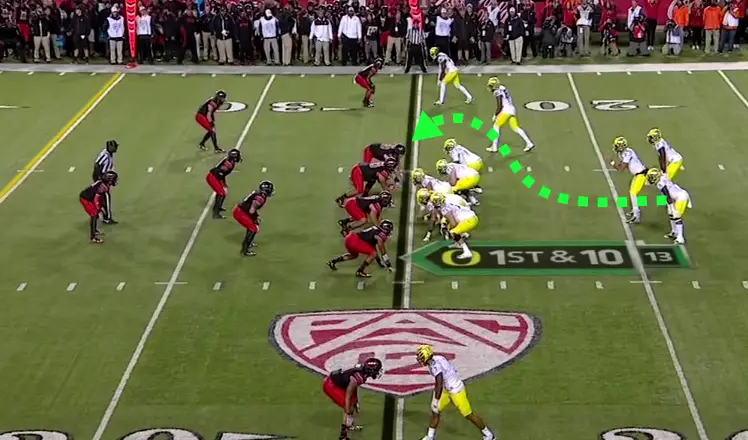
A hook block from a running back in the Straddled Triple Option formation?
This play variation above is just plain nasty on the defense as it has no idea that the set running play for the Oregon quarterback is coming at them. The Ducks will bring the FAR running back, not the near one — as in the last example — to “hook” the Ute defensive end responsible for outside contain on their left.
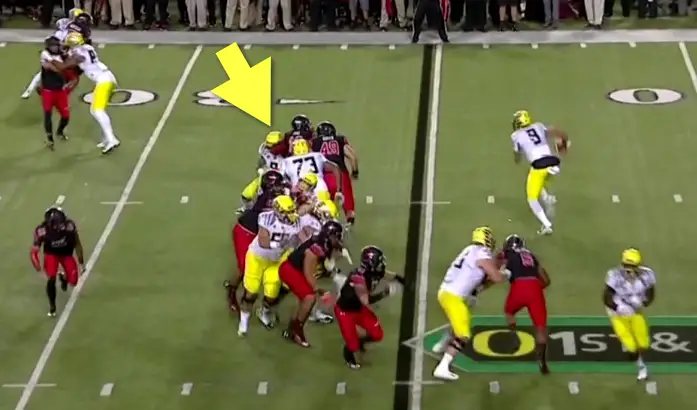
Can I have a football ManCrush?
As an old offensive tackle — I cannot contain my admiration for the skills of Byron Marshall. He makes defenders miss as a running back, he catches the ball as well as any wide-out, and he doesn’t just hit people with his blocks — he is cunning with them for maximum impact. Above he not only hooks around, but positions himself to take TWO defenders out! Note the Utah defenders on their right side still looking at Freeman.
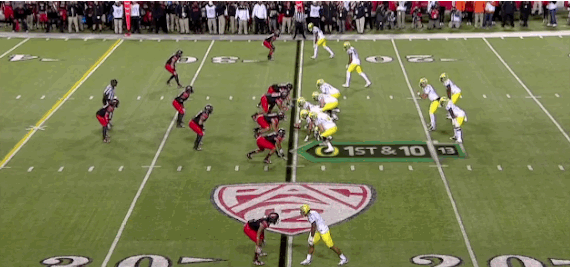
Perfectly done.
This is simply a beautiful play in design and execution above as the best damn blocking wide-receivers in the nation clear a lane along with Marshall for a monster play — and notice 6-5, 310 lb. freshman tackle Tyrell Crosby (No. 73) keeping up with the play! What appeared to be the beginning of a Straddled Triple Option turned into Oregon’s version of the “Loaded Option,” hence we have coined a new play in Oregon’s Playbook.
If you are a coach reading this — please look the special announcement for you below this article.

Coach Mike Morris was as surprised as the rest of us!
We have looked at three methods of how Oregon has implemented its own version of the “Loaded Option” to determine when it wishes to have predetermined QB running plays. The name is a misnomer as in reality it is not a option at all, but it is another variation within the Oregon offense for defenses to try to stop. During the days of the wishbone this strategy was so effective that QBs became the leading rushers on their teams!
It is also an example of the coaching staff composing plays and strategies to complement the talents of the players available — and what many think could be the finest running QB ever at Oregon. I want to thank the Grizzled Ol’ Coach, Mike Morris, for teaching this to me to share with all of you.
“Oh how we love to learn about our beloved Ducks!”
Charles Fischer (FishDuck)
Oregon Football Analyst for CFF Network/FishDuck.com
Eugene, Oregon
Top Photo from Video
Related Articles:

Charles Fischer has been an intense fan of the Ducks, a season ticket holder at Autzen Stadium for 38 years and has written reports on football boards for over 26 years. Known as “FishDuck” on those boards, he is acknowledged for providing intense detail in his scrimmage reports, and in his Xs and Os play analyses. He is single, has a daughter Christine, and resides in Eugene Oregon where he was a Financial Advisor for 36 years.
He now focuses full-time on Charitable Planned Giving Workshops for churches and non-profit organizations in addition to managing his two Oregon Football Websites, of FishDuck.com and the Our Beloved Ducks forum. He is a busy man!
He does not profess to be a coach or analyst, but simply a “hack” that enjoys sharing what he has learned and invites others to correct or add to this body of Oregon Football! See More…

